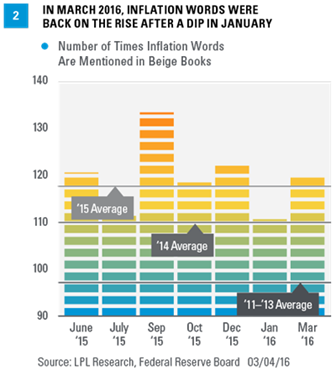Sentiment Snapshot
To evaluate the sentiment behind the entire Beige Book collage of data, we created our proprietary Beige Book Barometer (BBB) [Figure 1]. In March 2016, the barometer ticked down to just +39—the lowest reading since November 2012 (+30), which came in the aftermath of Superstorm Sandy’s impact on the East Coast. Notably, however, our BBB didn’t turn negative as it did during the summer and fall of 2011, amid the debt downgrade and debt ceiling debacle in the U.S. and fears of a sovereign default in the Eurozone that roiled global economies and financial markets. This suggests that the underlying economy in early 2016 is in much better shape than it was in late 2011, and thus better able to withstand the financial market turmoil.
At +39, the BBB remains well below its mid-2015 peak (+106 in July 2015), which followed a 40% bounce in oil prices from March to June 2015. The +106 reading in July 2015 was the highest reading since April 2013, and the second-highest reading in over 10 years. The downshift in the BBB from +106 in July 2015 to +39 in March 2016 traces, but doesn’t exactly match, the 50% drop in oil prices from June 2015 to early 2016. As we note in more detail below, however, most of the decline in the BBB since its 2015 peak has come in the non-energy-producing districts of the U.S, suggesting that there has been some spillover from lower oil prices to other parts of the economy and that the stronger dollar and economic weakness overseas are also acting as drags on the U.S. economy outside of the energy sector.
Watching Wages And Inflation
Now that the Fed has initiated its first rate hike cycle since 2006, FOMC members and market participants, who are trying to gauge what the Fed may do next, will be watching inflation closely. Each Beige Book provides an economy-wide assessment of wages and prices. The March 2016 Beige Book noted that “wages generally increased as most districts experienced slight to strong wage growth,” and that “labor market conditions continued to strengthen since the previous reporting period, with the majority of Districts reporting modest growth in the labor market.”
We monitor wage pressures via the data in Figure 2, which show the recent trend in the number of wage/inflation words in the Beige Book. We counted the number of times the words “wage,” “skilled,” “shortage,” “widespread,” and “rising” appeared in recent editions of the Beige Book. In March 2016, these words appeared 113 times, up from the 100 in January 2016, and above the 109 average seen in all 8 Beige Books in 2015. In all of 2014 — when deflation, not inflation, was a concern — those words appeared, on average, just 98 times per Beige Book; so after a brief drift back toward deflation worries in the January 2016, the latest edition shows a pickup in the number of inflation words. For reference, during 2011 – 13, also a period when heightened risk of deflation was evident, inflation words appeared, on average, 80 times per Beige Book.
Comments On Oil And Energy Spike Amid Volatile Oil Prices
Oil and energy received a total of 87 mentions in the March 2016 Beige Book, the highest reading since at least the start of 2014. The last Beige Book that even came close to seeing as many mentions of oil was the April 2015 Beige Book, with 83 mentions. For context, energy and oil had only around 40–45 
So far in 2016, oil prices have averaged around $32 per barrel, more than 33% below the average price in 2015 ($49 per barrel), which, in turn, was 48% below the 2014 average price of $92 per barrel.
To better gauge the impact of lower oil prices on the economy, we constructed a separate Beige Book Barometer [Figure 4] for the three Fed districts with the most energy-related economic activity (Minneapolis, Kansas City, and Dallas). During 2014, the Beige Book Barometer in the energy-related Fed districts averaged +18. In the 8 Beige Books released in 2015, the barometer in the energy-related districts was just +10, a clear deceleration in activity. In January 2016, the reading bounced back up to +18, but it cratered to -2 in the March 2016 Beige Book, reflecting the 20% drop in oil prices between mid-January 2016 and late February 2016 and the aforementioned announced capital expenditure cuts from U.S. energy producing companies. The -2 reading in March 2016 was the lowest since we began tracking this metric in early 2014.








